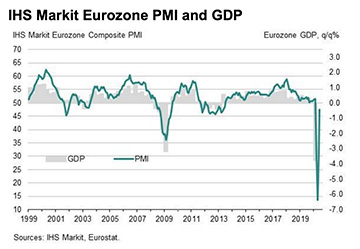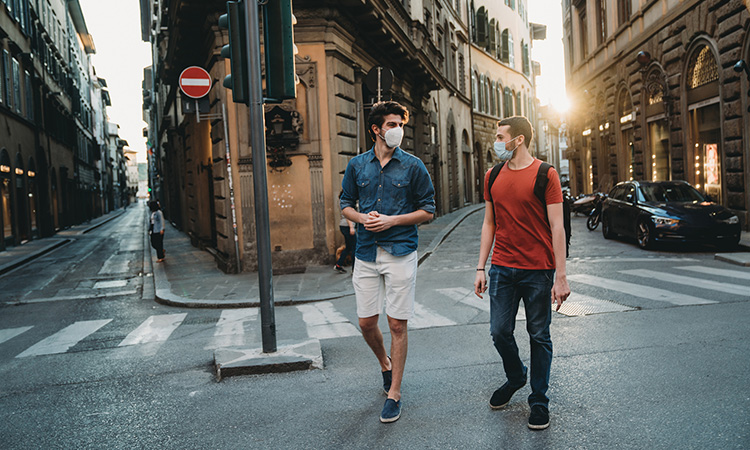
[Image: Getty Images]
In March, OPN talked with European optics and photonics professionals about how pandemic-induced lockdowns were affecting their lives and work. Now, three months later—with the flattening of the proverbial viral growth curve—many European societies have started easing those lockdowns, and find themselves peering down the murky road ahead.
During June, to gauge the current moment, OPN once again spoke with a number of photonic scientists in Europe. Their experiences underscore the widely varying effects—not all of them necessarily negative—wrought by the coronavirus shutdowns, and some of the near- and long-term changes that the pandemic may leave in its wake.
The macro impact
As measured by the popular IHS Markit purchasing manager's index (PMI), the crash in eurozone economic activity due to COVID-19 lockdowns was far swifter and deeper than the economic slowdown in the wake of the late-2000s financial crisis. Since April, however, signs of improvement have emerged as lockdown restrictions have eased. [Image: IHS Markit] [Enlarge image]
Clearly, the lockdowns have devastated the European economy. A popular indicator of month-to-month economic activity, the IHS Markit flash composite purchasing managers index (PMI), hit a sickening record low of 13.6 in the month of April for the eurozone countries and 13.8 for the United Kingdom. Any reading below 50 indicates a month-to-month economic contraction; hence, these record lows graphically illustrate how sudden and deep the coronavirus-induced cliff-dive in business activity has been.
Since that nadir, though, the news has improved a bit. For the eurozone countries, the flash PMI rose to 31.9 in May and 47.5 in June. (For the U.K., the numbers were 30.0 in May and 47.6 in June.) Both numbers suggest continued business contraction from the previous month—but also hint that the contraction has markedly slowed. Indeed, for France, the PMI jumped to 51.3 in June, pointing to a modest return to economic growth.
The slowing of the downturn, reflecting the gradual lifting of coronavirus restrictions and some resumption of economic activity, has the European business community itching for a possible return to growth in the second half. But given the lockdown’s destructive path of layoffs, business failures and possibly permanent structural changes—and evidence of a recent resurgence of global COVID-19 cases, particularly in the U.S.—the strength of any second-half recovery remains a very open question.
Short-term pain, long-term gain?
For optics and photonics in particular, companies in locked-down Europe have faced a toxic mix of tight financing, supply-chain squeezes and international-trade tensions.
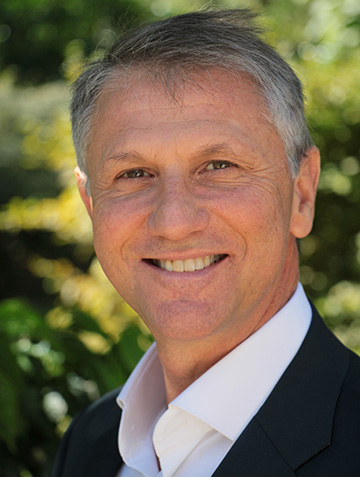
Giorgio Anania.
“Photonics companies in Europe tend to be small companies—SMEs with fragile balance sheets,” says Giorgio Anania, chairman and CEO of the France-based display technology company Aledia, and a vice president of the executive board of the European technology platform Photonics21. In the short term, he says, these companies have encountered “a very hard financing crush” as investors and venture capitalists have pulled in their horns, demanding more favorable terms and offering lower valuations in light of economic risks.
Europe’s photonics firms have also been whipsawed, according to Anania, by the high-profile trade standoff between the United States and China—and by what he calls the “legal arsenal” of extraterritoriality clauses that the U.S. has amassed to dictate trade terms in other areas, including Europe. These also, he says, have raised the perception of short-term risk in companies, such as those in European photonics, that depend on supply chains and technology relationships with China.
Surprisingly, despite these short-term setbacks, Anania believes that the same forces will be good for photonics in the long haul. He argues that these pressures will force countries to rethink long supply chains and global exposure, and to exert more control over their key technologies.
“Longer term, I think the situation is reversed,” Anania says. With all that has happened, “clearly there’s an intention by European governments to invest more in having their own resources, and that’s good for photonics in Europe.”
Greece: Opening up
For individual businesses and research labs, much big-picture uncertainty clearly remains, particularly about whether a potential “second wave” of viral infections will lead to new lockdowns. But for now, countries that have managed to stem the virus’ growth are cautiously reopening their economies. And, as a result, many in the optics and photonics community, stuck at home for the past several months, have started coming back to the lab.
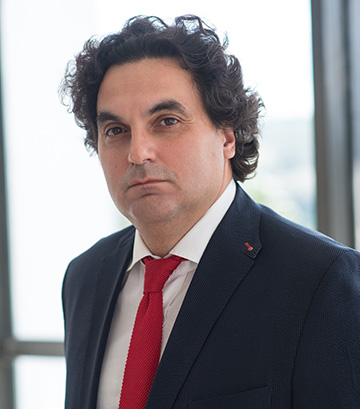
Stavros Pissadakis.
One interesting case is Greece, which has experienced a remarkably low coronavirus casualty toll—only 3,287 confirmed cases and 190 deaths as of mid-June. Stavros Pissadakis, the head of the Photonic Materials and Devices Laboratory of the Institute of Electronic Structure and Laser (IESL), Foundation for Research and Technology–Hellas (FORTH), Heraklion, Crete, credits that record to some “radical measures” imposed by the Greek government.
“At the beginning of March, we started having a kind of ‘red alert’,” he says. “And compared with the rest of Europe, we moved quite swiftly,” with restrictions on travel, work and ordinary activities. Pissadakis has been surprised by the speed of the response, and by the willingness of Greek citizens to go along. “Greeks organized coherently,” he says, “and their response this time was quite amazing—they followed the guidelines from the government very, very precisely.”
The tight, early controls in Greece allowed the country to start re-opening at the beginning of May, sooner than in many societies, with children returning to school by early June. At FORTH, Pissadakis says, the majority of the foundation’s activities are “back in place” and the labs are running again—but with strings attached. “In my lab, for instance, we cannot have more than two people working at the same time; we have to wear a mask when we collaborate with other people,” he notes. “We still refrain from physical meetings, and we work a lot with Skype. So things are not quite as they used to be”
Spain: “A deep shock”
The COVID-19 toll has been very different in Spain: nearly a quarter of a million confirmed cases and more than 28,000 fatalities as of mid-June. “In my opinion, Europe, the U.S. and most of the West did not pay proper attention to what was coming,” according to Lluís Torner, the head of the Institute for Photonic Sciences–ICFO in Barcelona. Torner notes that early on, the ICFO team modeled the patterns emerging from Wuhan, China, and was among the groups lobbying the government for action. The government’s lockdown came in mid-March.
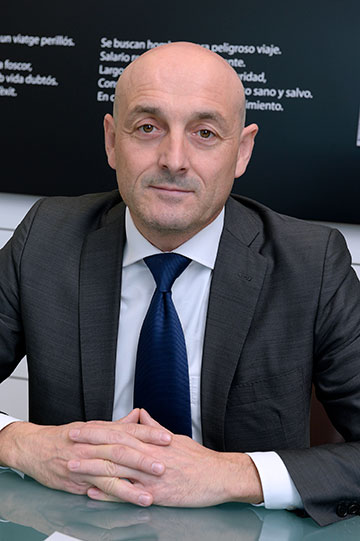
Lluís Torner.
“During the first few weeks, it was a deep shock, as it was strict,” Torner says, “and more than one thousand people died every day from the disease across the country.” At ICFO, meanwhile, the labs shut down and remote work began. That part of the process, at least, “has worked like clockwork,” according to Torner. “I am extremely proud of our collective attitude.”
Spain’s lockdown restrictions are now easing, and—except for large groups and gatherings, especially in closed spaces—most activities, including ICFO’s lab efforts, have resumed. “All experimental activities are running already at full speed,” Torner says. He also notes that the government has established working groups (some of which include ICFO scientists) to handle contingency plans for a possible second wave of the virus, and to set “societal and economic priorities for the next decade.”
U.K.: Emerging from “hibernation”?
In the United Kingdom, the government’s COVID-19 response has proved highly controversial, and the country’s experience with the virus has been brutal, with more than 308,000 confirmed cases and 43,000 deaths as of mid-June. Anna Peacock, with the Optoelectronics Research Centre at the University of Southampton, reports that the coronavirus shutdown this spring was very sudden—and that “a lack of clarity from the government at the outset, as to the seriousness of the situation” compounded the problem. “There were mixed messages, and some of the decisions being made were coming as a surprise to us.”
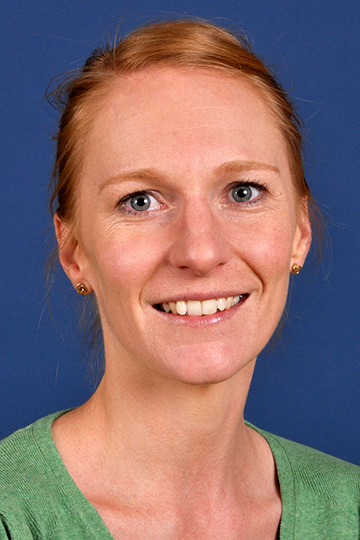
Anna Peacock.
The U.K. government is now courting further controversy with its plans for pulling back from lockdown, which Prime Minister Boris Johnson has referred to as emerging from a “long national hibernation.” For England at least, that reemergence envisions significant easing of social-distancing restrictions—without, some have argued, the necessary tracking-and-tracing capability to keep such a loosening safe.
At Southampton, however, Peacock says that the university is proceeding with significant caution. “The university looks like a very different place from the local high street,” she notes. The restrictions on campus remain “very tight,” according to Peacock, with only a small number of people whose work cannot be done remotely allowed to return—and under severe restrictions. Of her team, she says: “We’re running in a very limited capacity.”
Germany: “Science needs teamwork”
Germany, like Greece, managed to keep the coronavirus mortality very low, through what Cornelia Denz of the University of Münster calls “a very strict shutdown.” Because of the country’s success in keeping the virus in check, her team’s period of exile from the lab was relatively brief, with some personnel allowed to return in a matter of weeks.
“We were still advised to work mostly from home,” she says, “but we could go to the lab to continue our research work.” In addition, she notes that several funding agencies, including the German Research Foundation and the government’s Ministry for Science and Education, have offered to pay an extra three to six months’ salary for Ph.D.’s and postdocs under contracts that were derailed by the coronavirus—“a very generous approach,” she says.
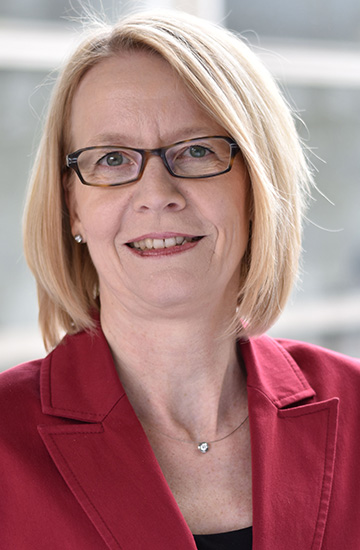
Cornelia Denz.
Though the lab is working again, Denz notes that undergraduate students are still barred from returning to classrooms. As a result, as at many institutions, Münster is doing all of its teaching online—which Denz calls “a very involved, very time-consuming process,” involving recording videos of lectures and synchronizing a variety of other visual aids. “I’d say it’s three times as much work as a classical lecture,” says Denz, “which means, of course, that we have less time for other activities.”
Denz also observes that while online teaching has some time-management benefit for students, it comes at a cost. “Our students tell us that they miss informal interactions with others” in settings such as student restaurants, learning spaces and teams. “Students might be suffering from it,” she says. Amid the current uncertainty, young people at a variety of career stages appear, in her view, to be having “really fundamental thoughts about the future.”
Anna Peacock also wonders about the pandemic’s impact on future education. “We just don’t know what our student body is going to look like next year, and for how many years it’s going to be impacted, so universities could shrink in size,” she says. “There is a lot of uncertainty ahead.”
“Science needs teamwork for the future,” Denz adds. “Big ideas only stem from teams that have diverse people with different backgrounds, and people that speak together.” Such serendipity, she says, is less likely to arise from Zoom meetings—and even face-to-face in research labs currently burdened by tightly policed social-distancing and separation rules.
Surprising outcomes
Denz thinks that, while researchers were able to write papers and do administrative work during the shutdown, the forced hiatus in lab work will ultimately affect her group’s productivity. The impact, she believes, is likely to be felt three to six months hence, when “the lab results are lacking that should lead to new papers. There will be a gap that will be felt afterward.”
Nonetheless, the period hasn’t been free of its positive aspects. Stavros Pissadakis at FORTH–IESL says that, disruptive as the lockdown period has been, he found it “quite useful to restructure many things”—to investigate new ideas, and to think about how his research group’s goals on photonic sensors, processes and codes of practice might be reshaped, potentially in radical ways. “At the end of the day, for me, it was an opportunity.”
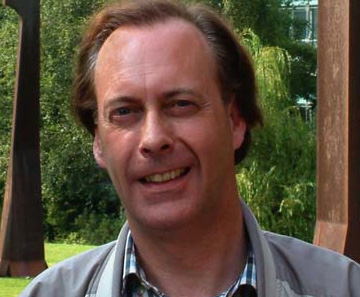
Iain Neil.
Indeed, for some optical consultants, the coronavirus created an unexpected surge of new business. Iain Neil is an optical design and technology consultant based in Lugano, Switzerland—a country that, on a per capita basis, was “pretty hard-hit” by the coronavirus, according to Neil, despite “a fairly strict lockdown from quite early on.” Yet he says that 2020 will, surprisingly, be “one of my busiest years,” and that he has heard a similar story from numerous other consultants in the optical-tech business.
The reason, says Neil, is that, while many clients had to close their factories, they kept their R&D efforts alive—and even accelerated some back-burnered projects, budget permitting. “The goal with some of my clients seemed to be, ‘Let’s be ready with some new product once this mess cleans up’,” Neil notes. He has even picked up new work during the lockdown from a client he has never actually met in person. “I’ve only spoken with them on Skype, and yet I have a contract with them.”
Fighting COVID with photons
As the coronavirus situation has unfolded, both government and EU scientific funding has largely coalesced around efforts to fight the virus. Some institutions have responded with an unusual interdisciplinary flair. Pissadakis notes that FORTH consists of eight research institutes—not just IESL in photonic science, but also others in areas such as molecular biology and biomedicine, applied math and computer science. “If you distribute the COVID-19 case along an extended value chain, you can see that FORTH can occupy several positions along the chain.”
As a result—with the extra impetus of some national seed funding—FORTH has been making an active effort to “create interdisciplinarity between the groups to address specific problems related to this pandemic,” according to Pissadakis. The organization has been putting lasers and photonics, machine learning, biotech and other disciplines together to explore faster clinical diagnostics of the coronavirus disease, as well as light-driven materials and techniques for disinfection.
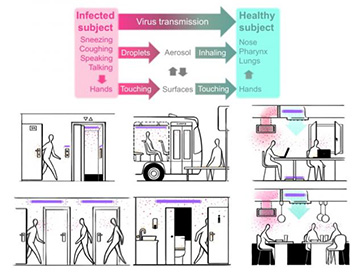
An ICFO-led international team recently put on the table some ideas for how antimicrobial UV-C light could be strategically deployed to help scrub the coronavirus from occupied public spaces, without endangering human health. [Image: Sketches by Nacho Gaubert] [Read the OPN story]
A similar spirit is alive at ICFO, according to Lluís Torner. One effort, led by Javier García de Abajo and recently published in ACS Nano, has brought together an international team of scientists in virology, immunology, aerosol physics, architecture and photonics to explore how UV-C light might be safely deployed in buildings to inactivate the SARS-CoV-2 virus indoors. And the institute is involved in other efforts (led by Turgut Durduran, in collaboration with hospitals) toward developing devices and advanced materials for the coronavirus battle.
Indeed, Photonics21’s Giorgio Anania even believes that the COVID-19 crisis, and some photonics-based technologies quickly developed to test for the coronavirus, may have raised Europe’s consciousness about the value of photonics as a target for technology investment. “People are realizing that photonics really is one of the industries for the future,” he says. “When you need fast reaction, when you need breakthroughs, photonics is there.”
Old biases re-emerging?
Yet if the pandemic has highlighted new opportunities in interdisciplinary science, it has also put pressure on old fault lines in family life and gender equity. In Germany, schools and kindergartens are “still almost in complete lockdown,” according to Cornelia Denz—a situation that has left parents scrambling to use scarce holiday and leave time to handle child care. “We could go back to lab work,” Denz says. “But for those who have families or have to care for people at home, there is almost no chance to go back into the workforce.”
The situation has proved particularly baleful for female scientific staff, most of whom are in dual-career couples. Denz has observed that “even in this group of highly academic, educated persons, 80% of the women in dual-career couples took over the care for children, while the men worked at home for their professions.” She fears that, as the lockdowns lift, women may increasingly find themselves relegated to home roles, especially given high unemployment levels. “It may be that highly skilled, highly educated women will enter a trap,” she says, “where, due to the coronavirus, they are more shifted to family work, and will not come out again.”
Denz ties some of this fear to a strain of German conservatism that seeks a return to “traditional” male–female roles. But the issue is far from limited to Germany. In the United Kingdom, for example, a late-May survey found that mothers were 23% more likely to have lost their jobs during lockdown than fathers, and were shouldering a far greater share of child care responsibilities than their homebound spouses.
Anna Peacock, at Southampton, believes that focusing on the pandemic’s impact on diversity and inclusion will be crucial as the world climbs out of the crisis. “This really does affect some groups in different ways from other groups,” she says. “And I think that’s going to be a really hard thing to untangle when we come out of this.”
Uncertain road ahead

[Image: Pixabay]
So what does all of this mean in the long haul for European optics and photonics? Iain Neil, the Swiss-based consultant, thinks that the pressure wrought by COVID-19, along with other changes such as the United Kingdom’s exit from the European Union, will just serve to accelerate changes that were afoot even before the coronavirus washed ashore.
The changes, he says, stem from a combination of factors: the eroding European manufacturing base in optics, the increasing influence of China, and the quickening pace of technological development itself. “There’s going to be an acceleration of change,” he says. “The way companies do business, the way they’re structured—they have to change.”
Cornelia Denz worries that many smaller companies, and even some larger ones, “may not survive” the current crisis. Funding for research could also come under pressure as it competes with the need for vast spending to resuscitate key industries crippled by the pandemic. “If the [German] government makes the decision to fund Lufthansa and the car business and other very big companies, then perhaps there’s less money for a few years for education and research.”
Yet Denz also stresses the positives that could emerge from the experience of the last few months. “As I see it, we could profit from some of the things we’ve learned,” she says—noting, for example, how digital learning tools might be implemented with conventional teaching in new kinds of “flipped” classrooms, and home office hours could be combined with classical office work to give families more options for handling caregiving tasks at home.
“Maybe,” says Denz, “we will learn, from this experience, to take better care of each other in ‘normal’ times as well.”
The European idea
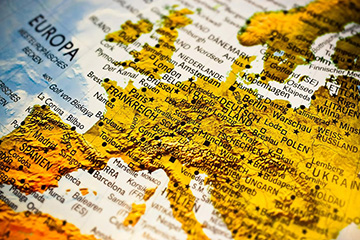
[Image: Pixabay.com]
From another perspective, Denz does wonder whether the “European idea” and a cohesive European Union may end up as casualties of the pandemic. She notes that individual member states have responded to the crisis by raising border restrictions, struggling with their own budgets, and otherwise looking out for their individual interests. “The European idea—which, I think, has made Europe strong in all respects—is going into the background,” Denz says. “This might be a bad thing for the future, because once those ties are broken, you don’t know if they’re coming back with the same speed.”
Giorgio Anania of Photonics21 takes a different line. “My view is clear—I think that ultimately, it strengthens Europe.” While he acknowledges that “step one in any country is doing what it needs to do to survive,” he believes the combination of the coronavirus crisis, the U.S.–China spat and extended, vulnerable global supply chains will increasingly “push Europe to band together.”
He finds encouragement, for example, in the fact that the continent’s largest economy, Germany—which, during the financial crisis after 2007, consistently stood against concerted European stimulus measures—has appeared much more expansive in the pandemic emergency. It has even supported (with France) the concept of eurozone bonds to help other crippled European economies through the crisis.
“I think Germany’s reaching the conclusion that it actually has more to gain longer term by having a village around it,” Anania concludes, “as opposed to just protecting its own home.”

